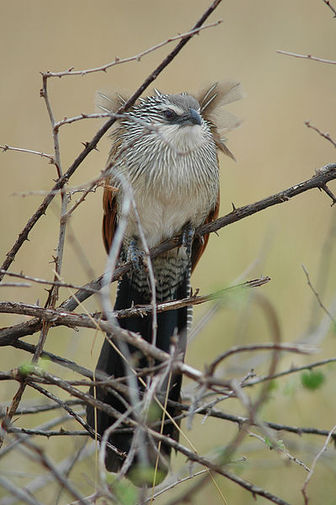White-browed Coucal
The southern subspecies is sometimes split as Burchell's Coucal, Centropus burchelli. According to popular Southern African lore, this species' distinctive call, which resembles water pouring from a bottle, is said to signal impending rainfall, earning the bird the affectionate moniker Rainbird.

Original source: frederic.saleinPermission(Reusing this file)This image, which was originally posted to Flickr.com, was uploaded to Commons using Flickr upload bot on 14:10, 6 September 2008 (UTC) by Martin H. (talk). On that date it was licensed under the license below. This file is licensed under the Creative Commons Attribution-Share Alike 2.0 Generic license.You are free:to share – to copy, distribute and transmit the work
Author: frederic.saleinPermission(Reusing this file)This image, which was originally posted to Flickr.com, was uploaded to Commons using Flickr upload bot on 14:10, 6 September 2008 (UTC) by Martin H. (talk). On that date it was licensed under the license below. This file is licensed under the Creative Commons Attribution-Share Alike 2.0 Generic license.You are free:to share – to copy, distribute and transmit the work
The White-browed Coucal is classified as Least Concern. Does not qualify for a more at risk category. Widespread and abundant taxa are included in this category.
The White-browed Coucal (Centropus superciliosus) is a species of cuckoo in the Cuculidae family. It is found in sub-Saharan Africa. The southern subspecies is sometimes split as Burchell's Coucal, Centropus burchelli. According to popular Southern African lore, this species' distinctive call, which resembles water pouring from a bottle, is said to signal impending rainfall, earning the bird the affectionate moniker Rainbird. References - * BirdLife International 2004. Centropus superciliosus. More
As with other members of the Centropidinae, the White-browed Coucal is non-parasitic. The males construct a nest, they then incubate the eggs and provide most of the feeding and care for the young. We've found Samburu to be a particularly good place to get good sightings of White-browed Coucals. The riverside vegetation along the Uaso Nyiro makes a perfect habitat for them. More
White-browed coucals tend to hide under shrubs, in the undergrowth and in dense water vegetation. They are not known for their flying and will go into hiding instead in a clumsy or awkward manner. Their singing sounds like water gurgling in a bottle, hence they are known in Kenya as the ‘water bottle bird’. Diet White-browed coucals have a wide diet which includes insects, young birds and eggs. More
The White-browed coucal is fairly common in Zimbabwe, Botswana and Mozambique, living in thick vegetation. It feeds on a wide a wide variety of animals, such as mammals, birds and insects. The nest is large sphere with a side entrance, made of grass blades or stems. It lays 3-5 eggs, which are incubated by both sexes, for 14-16 days. More
* The White-browed Coucal is the commonest coucal in East Africa. Want to Help? = A visit to the Cotswold Wildlife Park can now be even more worthwhile. By adopting an animal, you can provide a helpful contribution towards the costs of keeping and feeding the animals and supporting our conservation breeding programmes... More
This White-browed Coucal —also known as Burchell’s Coucal—is common in many parts of Africa. “Streaky and sneaky” best describes these birds, because you’ll be lucky if you see one. Dew from their dense habitat often dampens their feathers. Then, they hop to the top of a bush and spread their wings and tail to dry in the morning sun. Sign up for Weekly Preview, and receive email with photos of birds to be featured in the week ahead. More
White-browed Coucal (Centropus superciliosus) by Derek Solomon from Zambia XC41612 :: White-browed Coucal (Centropus superciliosus) = Recording data Recordist Derek Solomon Date 27-02-07 Time 06:00 Country Zambia Location South Luangwa National Park Home Longitude E31. More
Family : Cuculidae
Genus : Centropus
Species : superciliosus
Authority : Hemprich & Ehrenberg, 1833
